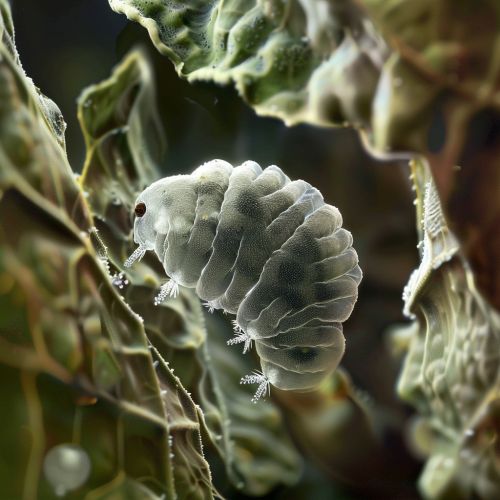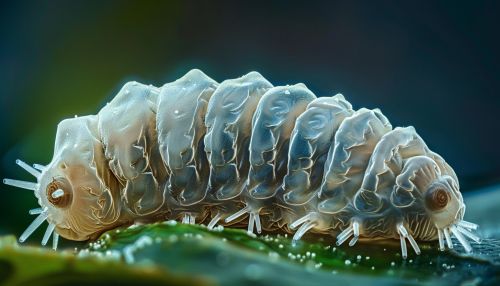Cryobiosis
Introduction
Cryobiosis is a biological state in which an organism's metabolic processes are significantly slowed down or halted due to extremely low temperatures. This state is a form of cryptobiosis, a broader term that encompasses various forms of metabolic suspension. Cryobiosis is observed in certain extremophiles, such as tardigrades, nematodes, and some species of rotifers, which can survive in environments that would be lethal to most forms of life. The study of cryobiosis has significant implications for fields such as astrobiology, cryopreservation, and understanding the limits of life.
Mechanisms of Cryobiosis
Cryobiosis involves a series of complex physiological and biochemical adaptations that allow organisms to withstand freezing temperatures. These adaptations include the production of cryoprotectants, the alteration of cellular membranes, and the stabilization of macromolecules.
Cryoprotectants
Cryoprotectants are substances that protect biological tissue from freezing damage. Common cryoprotectants include sugars like trehalose and glycerol, which prevent the formation of ice crystals within cells. These compounds work by lowering the freezing point of water and stabilizing cellular structures.
Membrane Alterations
Cellular membranes are particularly vulnerable to damage during freezing and thawing. Organisms that undergo cryobiosis often alter the lipid composition of their membranes to maintain fluidity at low temperatures. This adaptation helps prevent the rupture of cell membranes due to ice crystal formation.
Macromolecular Stabilization
Proteins and nucleic acids can denature or degrade at low temperatures. Cryobiotic organisms produce specific proteins and other molecules that stabilize these macromolecules, ensuring their functionality is preserved during and after the freezing process.


Examples of Cryobiotic Organisms
Several organisms exhibit cryobiosis, each with unique adaptations that enable them to survive extreme cold.
Tardigrades
Tardigrades, also known as water bears, are microscopic animals renowned for their resilience. They can survive temperatures as low as -272°C by entering a state of cryptobiosis, which includes cryobiosis. Tardigrades produce trehalose and other cryoprotectants to protect their cells during freezing.
Nematodes
Certain nematodes, or roundworms, can enter cryobiosis to survive freezing conditions. These organisms produce glycerol and other cryoprotectants to prevent ice formation within their cells. Nematodes also exhibit changes in gene expression that help them withstand cold temperatures.
Rotifers
Rotifers are microscopic aquatic animals that can survive desiccation and freezing by entering a state of cryptobiosis. They produce high levels of trehalose and other cryoprotectants, which protect their cells from damage during freezing and thawing.
Applications of Cryobiosis Research
The study of cryobiosis has several practical applications, particularly in the fields of cryopreservation and astrobiology.
Cryopreservation
Cryopreservation involves preserving biological samples at extremely low temperatures. Understanding the mechanisms of cryobiosis can improve techniques for preserving cells, tissues, and organs for medical and research purposes. Cryoprotectants and other strategies used by cryobiotic organisms are being studied to enhance the viability of preserved samples.
Astrobiology
Cryobiosis research has implications for astrobiology, the study of life in the universe. The ability of organisms to survive extreme cold suggests that life could exist on other planets or moons with harsh environments. Studying cryobiotic organisms helps scientists understand the potential for life beyond Earth.
Challenges and Future Directions
While significant progress has been made in understanding cryobiosis, several challenges remain. One major challenge is identifying all the molecular mechanisms involved in cryobiosis and how they interact. Future research aims to uncover these mechanisms and apply this knowledge to practical applications.
Molecular Mechanisms
Identifying the specific genes and proteins involved in cryobiosis is a key area of research. Advanced techniques such as genomics, proteomics, and metabolomics are being used to study these molecular components. Understanding how these molecules work together to protect cells during freezing could lead to new cryopreservation methods.
Practical Applications
Applying the principles of cryobiosis to practical applications, such as organ preservation and long-term storage of biological samples, is a major goal. Researchers are exploring ways to mimic the natural cryoprotectants and stabilization strategies used by cryobiotic organisms.
